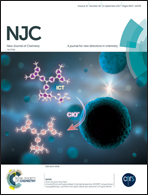Monodentate palladium(0)–[60]fullerene complexes of diphosphine ligands as efficient and sustainable nanocatalysts for the Mizoroki–Heck coupling reaction of aryl chlorides†
Abstract
Two mononuclear coordination complexes of fullerene[60] with Pd(dba)2 (dba = dibenzylideneacetone), [(η2-C60)Pd(Ph2P(CH2)2PPh2![[double bond, length as m-dash]](https://www.rsc.org/images/entities/char_e001.gif) C(H)C(O)R)2] (R = C10H7 (1), C6H4Cl (2)), have been prepared using a simple procedure to explore new directions in palladium catalysis and nanocarbon chemistry. The palladium(0)–[60]fullerene complexes incorporating unsymmetrical phosphorus ylides have been characterized by 1H, 13C and 31P NMR spectroscopic methods and other conventional techniques such as IR, TGA, SEM, ICP-OES, EDX and TEM analysis. Attributed to the enhanced dispersity and uniform size of the Pd nanoparticles with phosphine-functionalized fullerenes, the prepared catalysts exhibited comparable catalytic activity to those reported for the Mizoroki–Heck coupling reaction of aryl chlorides. Because of their abundance and low cost, aryl chlorides are the most desirable substrates from an industrial point of view in Csp2–Csp2 coupling reactions. Furthermore, overall bonding modes in the palladafullerenes of bifunctional diphosphine-based ligands were investigated by spectroscopic analysis and theoretical calculations. DFT studies of geometry-optimized monodentate and bidentate structures for 1 were calculated at the B3LYP/LANL2MB level of theory to understand the origin of the observed coordination modes.
C(H)C(O)R)2] (R = C10H7 (1), C6H4Cl (2)), have been prepared using a simple procedure to explore new directions in palladium catalysis and nanocarbon chemistry. The palladium(0)–[60]fullerene complexes incorporating unsymmetrical phosphorus ylides have been characterized by 1H, 13C and 31P NMR spectroscopic methods and other conventional techniques such as IR, TGA, SEM, ICP-OES, EDX and TEM analysis. Attributed to the enhanced dispersity and uniform size of the Pd nanoparticles with phosphine-functionalized fullerenes, the prepared catalysts exhibited comparable catalytic activity to those reported for the Mizoroki–Heck coupling reaction of aryl chlorides. Because of their abundance and low cost, aryl chlorides are the most desirable substrates from an industrial point of view in Csp2–Csp2 coupling reactions. Furthermore, overall bonding modes in the palladafullerenes of bifunctional diphosphine-based ligands were investigated by spectroscopic analysis and theoretical calculations. DFT studies of geometry-optimized monodentate and bidentate structures for 1 were calculated at the B3LYP/LANL2MB level of theory to understand the origin of the observed coordination modes.
![Graphical abstract: Monodentate palladium(0)–[60]fullerene complexes of diphosphine ligands as efficient and sustainable nanocatalysts for the Mizoroki–Heck coupling reaction of aryl chlorides](/en/Image/Get?imageInfo.ImageType=GA&imageInfo.ImageIdentifier.ManuscriptID=C7NJ00741H&imageInfo.ImageIdentifier.Year=2017)


 Please wait while we load your content...
Please wait while we load your content...